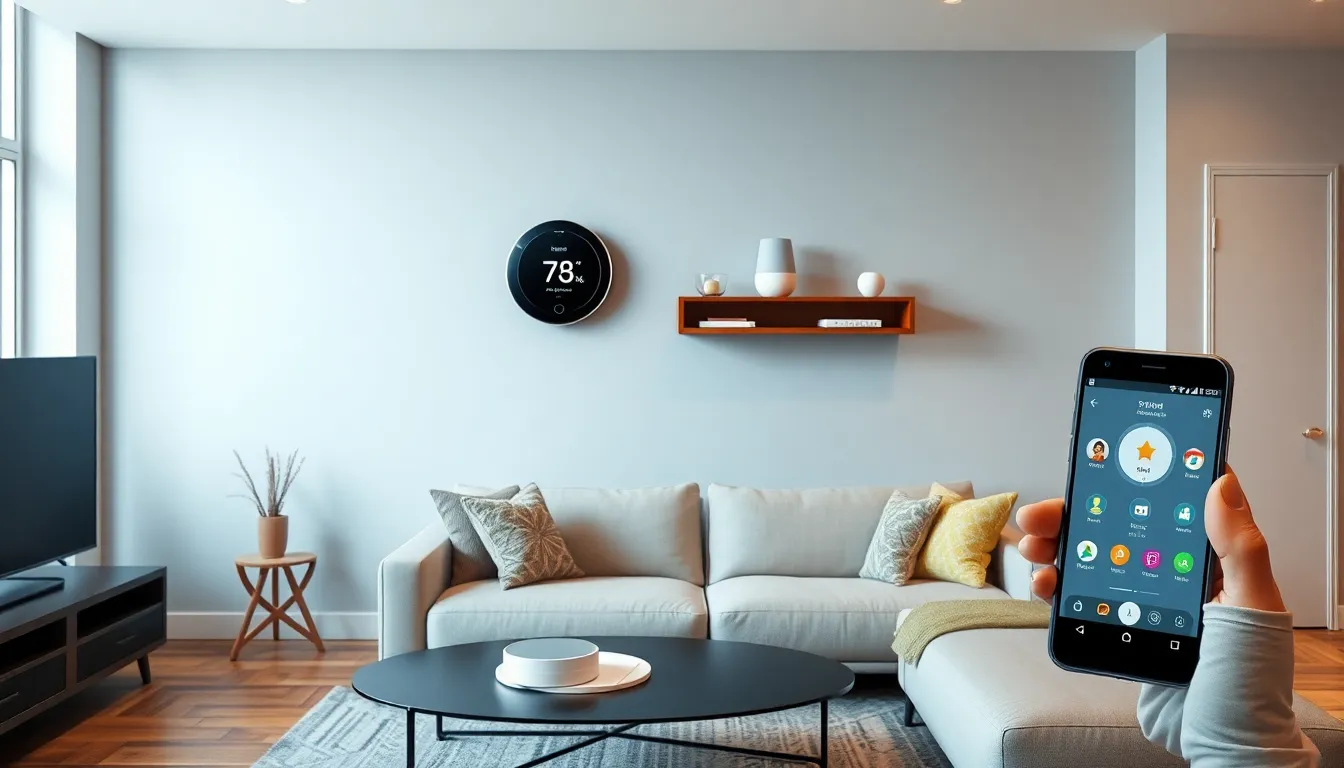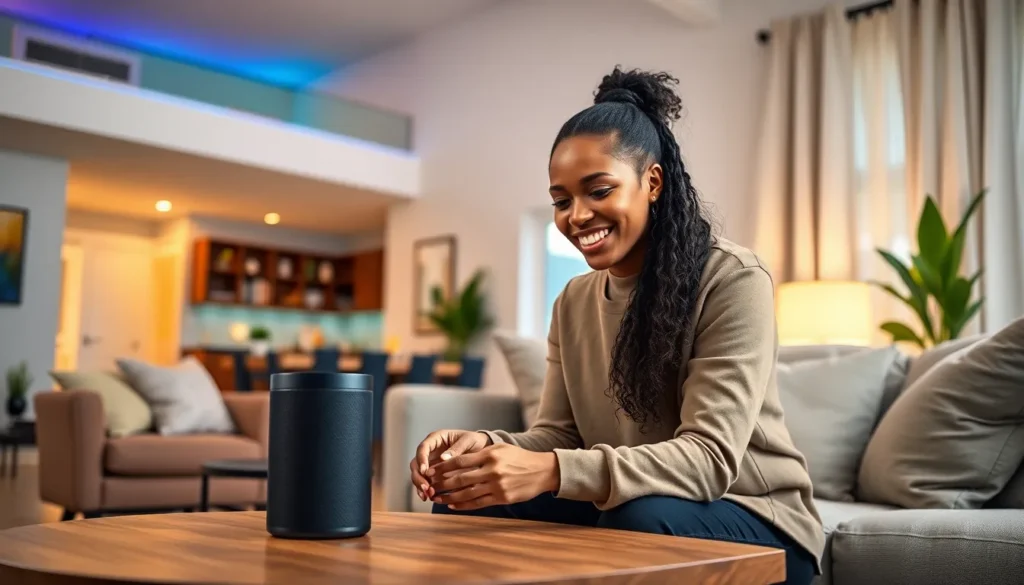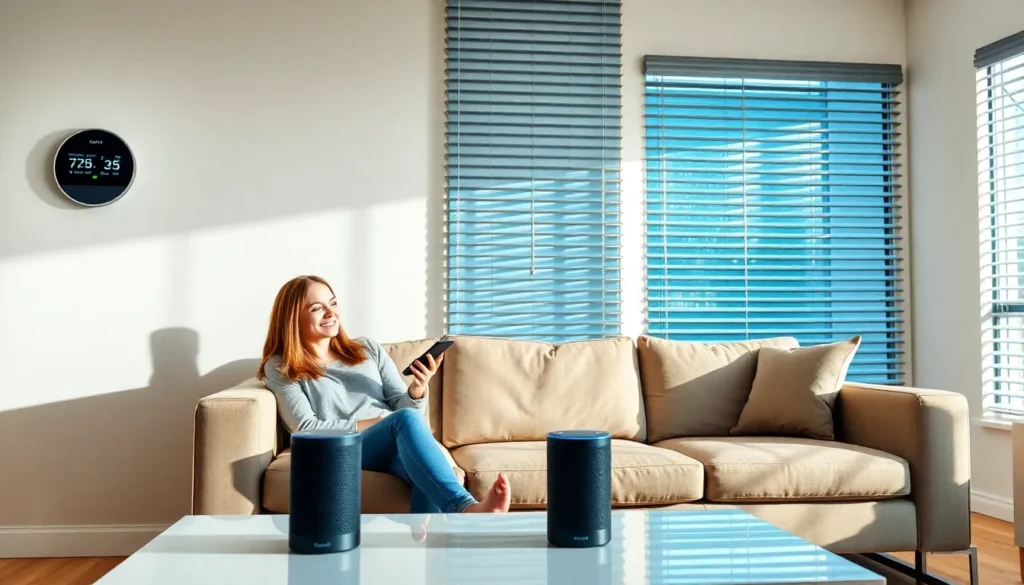Table of Contents
ToggleHome automation isn’t just for tech geeks anymore; it’s the new norm for anyone wanting a smarter, more efficient living space. Imagine controlling your lights, thermostat, and even your coffee maker with just a few taps on your smartphone. Sounds like something out of a sci-fi movie, right? Well, it’s time to embrace the future because these trends are here to stay.
Overview of Home Automation Trends
Home automation has gained significant traction among diverse audiences. Individuals prioritize the integration of smart devices to simplify daily tasks. This trend extends beyond tech enthusiasts, appealing to families and retirees alike.
Key devices include smart lighting systems, which adjust automatically based on occupancy or time of day. Thermostats now learn user preferences, optimizing energy use while enhancing comfort. Voice-activated assistants also play a crucial role, enabling hands-free control of home environments.
Data from industry sources shows that the global smart home market is projected to reach $174 billion by 2025. Growth stems from innovations like advanced security systems and smart appliances that communicate seamlessly. These devices enhance convenience, efficiency, and security.
Adoption rates are increasing due to user-friendly interfaces offered by leading brands. Many manufacturers incorporate artificial intelligence, allowing devices to learn and adapt to user habits. Homeowners appreciate the increased energy efficiency, leading to cost savings on utility bills.
Privacy and security remain primary concerns as the number of connected devices rises. Manufacturers are enhancing encryption technologies and user control over data to address these issues. Consumers seek reassurance regarding data protection, making transparency critical for companies.
Investments in home automation show no signs of slowing down. Stakeholders continue to push for smarter, more cohesive living environments. Continued advancements will shape the way individuals interact with their homes, ensuring comfort and convenience remain top priorities.
Emerging Technologies in Home Automation

Emerging technologies continue to reshape home automation, driving advancements that enhance user experience. Two key technologies are artificial intelligence and machine learning, along with the Internet of Things.
Artificial Intelligence and Machine Learning
Artificial intelligence and machine learning enable smart devices to adapt to user preferences. By analyzing behaviors, these technologies improve energy efficiency and convenience. For instance, learning thermostats adjust settings based on usage patterns. Automation systems with voice-activated assistants enhance interaction, allowing users to control devices hands-free. As more homeowners embrace these innovations, investments in AI-driven technologies are expected to grow, making homes smarter and more responsive.
Internet of Things (IoT)
The Internet of Things plays a critical role in home automation by connecting devices seamlessly. Smart gadgets, such as security cameras and lighting systems, communicate over the internet, enabling real-time monitoring and control. Homeowners appreciate the convenience offered by IoT, allowing them to manage systems remotely through smartphones. As the number of connected devices rises, interoperability becomes essential, prompting manufacturers to enhance compatibility across platforms. The IoT landscape continues to evolve, making home automation increasingly accessible and efficient for diverse households.
Popular Home Automation Devices
Home automation devices enhance everyday living through convenience and efficiency. Several categories stand out, each providing distinct advantages.
Smart Speakers and Assistants
Smart speakers and assistants serve as command centers for home automation. Devices like Amazon Echo and Google Nest Hub enable voice control of various systems. Users can adjust settings for lights, thermostats, and entertainment systems just by speaking. Integration with multiple platforms allows seamless operation across various devices. In 2022, 57% of US households owned smart speakers, reflecting their increasing popularity. Families enjoy hands-free convenience while cooking or managing children’s activities. Moreover, updates in voice recognition technology improve accuracy, making interactions more intuitive.
Intelligent Lighting Solutions
Intelligent lighting solutions revolutionize how individuals illuminate their homes. Smart bulbs, such as Philips Hue and LIFX, offer customizable brightness and color options. Users can schedule lighting or adjust it based on presence detected in the room. In fact, about 40% of smart home users invest in lighting solutions. Energy efficiency is also a major benefit, with many intelligent systems using less power than traditional bulbs. These technology advancements create ambiance and contribute to energy savings. Additionally, compatibility with smart assistants enhances user experience, allowing for easy adjustments through voice commands.
Security and Privacy Concerns
The rise of home automation brings forth notable security and privacy concerns. Users worry about data protection and the potential misuse of personal information within connected devices.
Data Protection Measures
Manufacturers enhance encryption technologies to safeguard sensitive data. Strong encryption protects user information during transmission between devices and cloud servers. Multi-factor authentication adds an additional layer of security, making unauthorized access more difficult. Regular software updates address vulnerabilities, keeping devices safe from emerging threats. Homeowners benefit from using strong, unique passwords for their smart devices, reducing the risk of hacking. Understanding the significance of data protection ensures a safer smart home experience.
Consumer Awareness
Increased awareness among consumers shapes the demand for secure home automation solutions. Consumers actively seek devices with robust privacy features, influencing purchasing decisions. Educational resources about potential risks help users make informed choices. Research indicates that 70% of homeowners prioritize security when implementing automation technologies. Awareness campaigns highlight safe practices, such as disabling unnecessary data sharing options. Dedicated consumers drive the market towards smarter, more secure products, fostering confidence in home automation.
The Future of Home Automation
Home automation continues to advance, with innovations pushing boundaries in everyday living. One significant trend involves the integration of artificial intelligence and machine learning into smart devices. These technologies allow devices to learn user preferences, enabling tailored experiences that enhance energy efficiency and convenience.
Telecommunication technologies, like the Internet of Things, facilitate seamless connectivity among devices. High interoperability emerges as homeowners connect numerous smart devices for comprehensive control. Increased reliance on smartphones means users appreciate remote management capabilities of their systems. In fact, more than 80% of homeowners utilize their smartphones to monitor and adjust home technologies.
Security remains a primary concern as the home automation sector expands. As of now, 70% of homeowners consider security pivotal when choosing automation solutions. Manufacturers respond by enhancing encryption technologies, implementing multi-factor authentication, and consistently updating software for user protection.
Growth in the smart home market signals a broader acceptance of these technologies. Statistical forecasts suggest the sector could reach $174 billion by 2025. Popular devices like smart speakers and intelligent lighting systems reflect this trend, with 57% of U.S. households owning smart speakers as of 2022. Additionally, about 40% of smart home users invest in customizable lighting systems, demonstrating a strong desire for personalization and energy savings.
Overall, investments in home automation technologies continue to shape interactions within living spaces. Innovative solutions not only create a smarter home environment but also prioritize user security. As consumers become more informed, demand for secure, efficient products increases, leading to a thriving market.
The evolution of home automation is transforming how people interact with their living spaces. As technology becomes more accessible and user-friendly, homeowners are embracing smart devices to enhance convenience and efficiency. With a focus on security and privacy, manufacturers are responding to consumer demands by prioritizing robust encryption and data protection measures.
The integration of AI and IoT continues to drive innovation, making it easier for users to manage their homes remotely. As the market grows, the emphasis on interoperability and seamless connectivity will play a crucial role in shaping future trends. Home automation is not just a passing fad; it’s a significant shift towards smarter living that prioritizes user experience and security.







